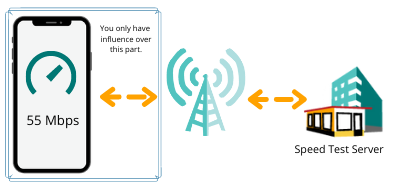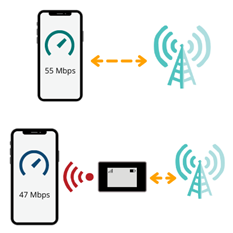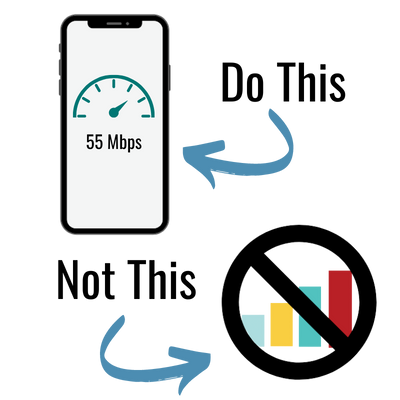Testing Mobile Internet Speeds
When it comes to testing your mobile internet connection, measuring actual performance is a lot more important than bars.
Paying attention to signal strength is helpful, but it’s even more informative to focus on actual speed tests in order to tweak your setup, in order to get the best download or upload performance depending on your needs.
Here are some tips and tricks for running speed tests, and understanding your speed test results.
Bars versus Speed
The bars that you see on your phone or hotspot are giving you an indication of signal strength, which does not always directly correlate to data performance. For that, you have to measure the actual performance that you are getting, and that is where speed tests play a role.
So just what is a speed test and what is it doing?
When a speed test is running, it is trying to measure the connection speed between your device and a server somewhere on the internet. It does this by sending a data stream from your device up, and then another data stream down. So the test measures both upload and download speeds, and it also gets a few other bits of data to help indicate what your performance is actually like.
 There are many different speed test services, such as Speedtest.net or Fast.com, and while they each work a little differently, many of them measure a few common things. Here’s a breakdown of some of the various details a speed test service might measure, and what the results mean.
There are many different speed test services, such as Speedtest.net or Fast.com, and while they each work a little differently, many of them measure a few common things. Here’s a breakdown of some of the various details a speed test service might measure, and what the results mean.
Download Speed
The primary thing most speed test services test is download speed, which is one of the most important measurements. Download speed measures how fast data is coming to you. It affects how fast pages will load, how pictures will render, and how smooth video streaming will be.

A download speed of 50 Mbps or higher will be blazing fast, and will allow you to easily download large files and run multiple video streams. Download speeds around 20 Mbps will still feel pretty good, and even download speeds as low as 5 Mbps are still very usable. But once you are below 5 Mbps, you may see problems with some internet tasks.
Upload Speed
The next thing a speed test will measure is upload speed, which is usually not as critical for the things most people do while online. But if you need to do activities like 2-way video broadcasting, Zoom meetings, or large file uploads, then upload performance is important.

With upload speeds of 20 Mbps or higher, you should easily be able to do video broadcasting in high resolution, and upload large files in a jiffy. Speeds of 10 Mbps should still be nice and smooth, and video broadcasting can be done in high resolution. Speeds of 5 Mbps should still be pretty good, but video broadcasting may need to be done in 720p. Once you get below 5 Mbps, video broadcasting will probably need to be done in SD, and once you go below 1 Mbps, your connection will be pretty unreliable.
Latency/Ping
Latency, or ping time, is the time it takes for a data packet to go from your computer to the server, and then back to you. Lower ping times means things are more responsive, while higher ping times will mean lots of delays and lags.
On a cellular connection, a good ping time on 4G/LTE is 30-50ms, and on 5G it should be 15-30ms. If the ping time is over 100ms, that’s a sign of an unreliable connection.
If you’re using Starlink, good ping times could be as low as 20ms. On a geostationary satellite, ping times are typically much slower, often around 500ms, which is very slow and unresponsive.
Jitter
Jitter shows how much the ping time varies, or how loaded the connection is. High jitter numbers indicate a sluggish or unstable connection. Single-digit jitter numbers indicate a more stable connection.
Packet Loss
Some speed tests report a percentage of packet loss, which is an indication of how much data is dropped along the way. Substantial and persistent packet loss on a connection means web pages may not reliably load and streaming connections can drop. Zero packet loss is ideal, but even 1% packet loss can make a connection feel unreliable.
Server Used for the Test
Some speed test services have many different servers on the internet they use for testing. Most speed test services pick a server that it thinks is closest to you, or that will provide the best performance. Switching to a different speed test server may give different results.
Once you find the speed test server that you want to use, be sure to use that one consistently for all of your testing. And remember that a speed test is just one measurement tool and does not have any impact on your actual internet performance.
Tips for Testing
Before diving into testing internet speeds, think about what exactly it is that you want to test, so that you can best determine how to set up your testing procedure.
For example, if you want to test your phone’s cellular connection speed, then simply run the test using your phone while it’s connected via cellular. But if you want to test a data plan associated with a router or mobile hotspot device, then you’ll need to connect your phone (or tablet or computer) to the router or mobile hotspot, and then run the tests.
Keep in mind that if you are testing a mobile hotspot or router connection, the wireless hop (from the hotspot/router to your phone) may be a factor in performance. Using an ethernet connection from a computer to the hotspot can eliminate problems of slow Wi-Fi messing with your test results.

It’s important to remember that each test is just a snapshot of the current conditions between your device and the testing server. Results can vary quite a bit day to day, or even hour to hour. Take multiple tests and record your results so that you can get a better overall picture.
Another important thing to keep in mind is that the data used for these speed tests will count against the data you’re allotted on your data plans. Be careful with how much testing you do so you don’t use all your data if you have a limited amount.
Summary
When evaluating your connection it’s best to test your actual performance rather than looking at bars on your device. Speed testing will give you a much more accurate picture of how good your connection is.
Testing your speeds is really only the first step in making sure you have a usable connection. Once you know what your speeds are, there are additional things you can do to try to optimize that connection if needed.
 While it can be fun to try to get the fastest speed test numbers you can, remember to focus on the performance you actually need. Spending time tweaking, testing and optimizing to get better performance that you don’t actually use, is probably a waste of time. Once you get your connection to be good enough….that’s probably good enough! And then you can focus your bar-hunting skills on happy hour instead.
While it can be fun to try to get the fastest speed test numbers you can, remember to focus on the performance you actually need. Spending time tweaking, testing and optimizing to get better performance that you don’t actually use, is probably a waste of time. Once you get your connection to be good enough….that’s probably good enough! And then you can focus your bar-hunting skills on happy hour instead.
Here are some of our additional resources that will give you more detailed information on testing, and things you can to enhance your connection.
Did you like this post? Pin it on Pinterest!


Author
Jen Nealy
Jen and her husband Deas have been traveling in their RV since 2013, during which time they estimate they have had at least 1000 happy hours. They travel with their dogs Shorty and Jake, and blog at nealysonwheels.com.

 Previous Post
Previous Post Next Post
Next Post
Very good post about speed tests vs cell signal. As an IT Engineer, I would like to point out that a lot of individuals get caught up in speed tests. They are a great trouble shooting tool, but they are just a value at one small point in time. If you only look at a speed test, and not an average of them, then it is hard to know the whole picture. It is like opening your blinds looking out side the window to see the weather. You see a nice sunny day, and then in 4 hours you decide to go for a walk only to find out it is raining. Same with speed tests. I have been doing a speed test every hour for the last 8 months or so. Here is an example of my speed tests in the last few hours. 72, 44, 79, 246, 185, 125, 171, 194, 125, 100, 81, 48, 17, 37, 22 Mbit/s. A lot of individuals will do a speed test with one service, Starlink, ATT, Verizon, etc, then in 5 min test another one, and then say that X was better than Y… Well it was right at that point in time.
Just some thoughts. Again thanks for you post, it will help a lot of people.